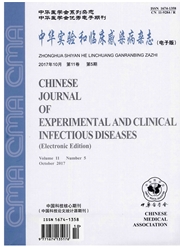

 中文摘要:
中文摘要:
瞄准:调查在肝炎 B e 抗原(HBeAg ) 的为 acute-on-chronic 肝炎 B 肝失败(ACLF-HBV ) 的为 entecavir 的治疗学的功效的最佳的预定否定病人。方法:有 ACLF-HBV 的 109 个住院病人的一个总数从第三所隶属于的医院的传染疾病的部门被招募,从 2007 年 10 月的孙中山大学到 2010 年 10 月。Entecavir 0.5 mg/d 被加到每个病人全面治疗学的政体。病人们为结束阶段肝疾病根据模型的意见被划分成三个组(吞没) 分数:高(30, 20 男性和 4 女性,意味着年龄 47.8?
 英文摘要:
英文摘要:
AIM: To investigate optimal timing for therapeutic efficacy of entecavir for acute-on-chronic hepatitis B liver failure (ACLF-HBV) in hepatitis B e antigen (HBeAg)negative patients. METHODS: A total of 109 inpatients with ACLF-HBV were recruited from the Department of Infectious Diseases of the Third Affiliated Hospital, Sun Yat-sen University from October 2007 to October 2010. Entecavir 0.5 mg/d was added to each patient's comprehensive therapeutic regimen. Patients were divided into threegroups according to model for end-stage liver disease (MELD) score: high (≥ 30, 20 males and 4 females, mean age 47.8 ± 13.5 years); intermediate (22-30, 49 males and 5 females, 45.9 ± 12.4 years); and low (≤ 22, 28 males and 3 females, 43.4 ± 9.4 years). Statistical analysis were performed using SPSS 11.0 software. Data with normal distribution were expressed as mean ± SD and comparisons were made with Student's t tests. A value of P 〈 0.05 was considered statistically significant. Viral loads were related exponentially and logarithmic data were used for analysis. RESULTS: For 24 patients with MELD score ≥ 30, treatment lasted 17.2 ± 16.5 d. Scores before and after treatment were significantly different (35.97 ± 4.87 and 40.48 ± 8.17, respectively, t = -2.762, P = 0.011); HBV DNA load was reduced (4.882 ± 1.847 copies log10/mL to 3.685 ± 1.436 copies log10/mL); and mortality rate was 95.83% (23/24). Of 54 patients with scores of 22-30, treatment lasted for 54.0 ± 43.2 d; scores before and after treatment were 25.87 ± 2.33 and 25.82 ± 13.92, respectively (t = -0.030, P = 0.976); HBV DNA load decreased from 6.308 ± 1.607 to 3.473 ± 2.097 copies log10/mL; and mortality was 51.85% (28/54). Of 31 patients with scores ≤ 22, treatment lasted for 66.1 ± 41.9 d; scores before and after treatment were 18.88 ± 2.44 and 12.39 ± 7.80, respectively, (t = 4.860, P = 0.000); HBV DNA load decreased from 5.841 ± 1.734 to 2.657 ± 1.154 copies log10/mL; and m
 同期刊论文项目
同期刊论文项目
 同项目期刊论文
同项目期刊论文
 期刊信息
期刊信息
